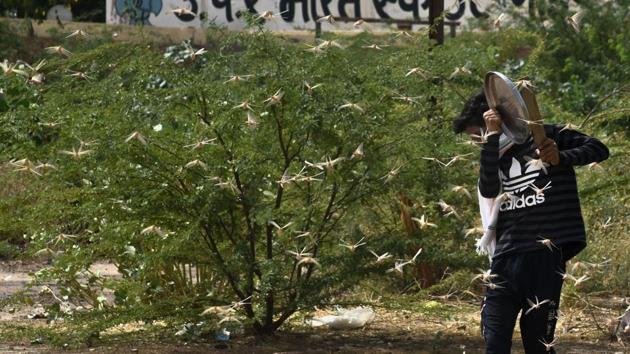
Good rainfall in Rajasthan, other parts of northwest India, and cyclone Nisarga forming over the Arabian Sea will create favourable conditions for the breeding of crop-munching desert locusts along the India-Pakistan border but temporarily stall their movement as well, the Centre's Locust Warning Organisation (LWO) said.
"If there are good rains in Rajasthan, they will stay in the desert region and not move away, and if mature swarms come, they will breed here in the next 15 to 30 days depending on weather conditions," said LWO deputy director K L Gurjar.
Locust swarms reached new locations, chomped through vegetation and crops across farmlands in Punjab, Madhya Pradesh, Maharashtra, Gujarat, Uttar Pradesh and Chhattisgarh and prompted the Centre to issue a warning to 16 states last week. "They are presently in Madhya Pradesh's Shivpuri area and moving towards Ashok Nagar, Bikaner and Nagaur in Rajasthan, Nagpur in Maharashtra and Jhansi in Uttar Pradesh. They are unlikely to move towards Bihar," said Gurjar. He added LWO controlled a new swarm that entered Jaisalmer on Sunday.
Locust swarms pose a severe risk to India's agriculture this year, the UN has warned, and prompted the authorities to step up vigil, and deploy drones and other equipment to detect their movement. Their attacks are known to cause a considerable drop in agricultural output. Locusts can fly up to 150km in a day and a one-square-kilometre swarm can eat as much food as 35,000 people.
R K Jenamani, a senior scientist at the National Weather Forecasting Centre, said the formation of any cyclonic circulation over the Arabian Sea brings moisture into north India and causes rain. "We are expecting thunderstorm and rainfall activity in east Rajasthan and in Delhi NCR [National Capital Region] on June 4 and 5. It has already been raining in parts of east Rajasthan," he said.
Northwest India is expected to receive excess monsoon rainfall at 107% of the long-period average this year, according to India Meteorological Department. Excess monsoon rains will also provide favourable conditions for the breeding of locusts in arid areas.
According to the Food and Agriculture Organisation (FAO), moist sandy or sand/clay soil to depths of 10-15 cm below the surface, some bare areas for egg-laying, and green vegetation for hopper development are the favourable conditions for their breeding.
LWO has said it has controlled swarms over 55,000 ha across Rajasthan, Uttar Pradesh and Madhya Pradesh mainly by spraying pesticides.
According to FAO's update dated May 27, locust swarms are forming in the spring breeding areas and migrating east to the India-Pakistan border ahead of the monsoon.
"Spring-bred immature adult groups and swarms that arrived in Rajasthan from the west continued to move east in the eastern portion of the state and to the central states of Madhya Pradesh and Maharashtra. As of 26 May, at least one swarm had reached to the northeast of Bhopal. Much of these movements were associated with strong westerly winds from Cyclone Amphan in the Bay of Bengal. Control operations are underway," it said.
Several successive waves of swarms can be expected until July in Rajasthan with eastward surges across India as far as Bihar and Odisha followed by westward movements and a return to Rajasthan based on changing monsoon winds. These movements will cease as swarms begin to breed and become less mobile. Swarms are less likely to reach south India, FAO said.
Sign on to read the HT ePaper epaper.hindustantimes.com